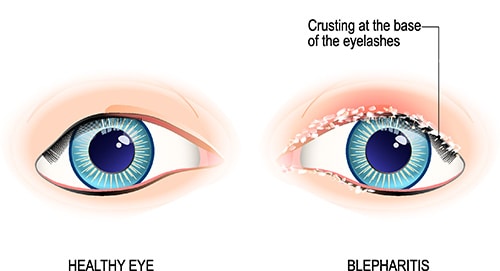
Blepharitis is an inflammation of the eyelids in which they become red, irritated and itchy and dandruff-like scales form on the eyelashes. It is a common eye disorder caused by either bacteria or a skin condition, such as dandruff of the scalp or rosacea. It affects people of all ages. Although uncomfortable, blepharitis is usually not contagious and generally does not cause any permanent damage to eyesight.
Blepharitis is classified into two types:
- Anterior blepharitis occurs at the outside front edge of the eyelid where the eyelashes attach.
- Posterior blepharitis affects the inner edge of the eyelid that touches the eyeball.
People with blepharitis may experience a gritty or burning sensation in their eyes, excessive tearing, itching, red and swollen eyelids, dry eyes or crusting of the eyelids. For some people, blepharitis causes only minor irritation and itching. However, it can lead to more severe symptoms, such as blurring of vision, missing or misdirected eyelashes, and inflammation of other eye tissue, particularly the cornea. By touching and rubbing the irritated area, a secondary infection can also result. By touching and rubbing the irritated area, a secondary infection can also result.
In many cases, good hygiene can help control blepharitis. This includes frequently washing the scalp and face, using warm compresses to soak the eyelids and scrubbing the eyelids. When a bacterial infection is causing or accompanies blepharitis, antibiotics and other medications may be prescribed.
What causes blepharitis?
Anterior blepharitis is commonly caused by bacteria (staphylococcal blepharitis) or dandruff of the scalp and eyebrows (seborrheic blepharitis). These bacteria are commonly found on the face and lids, but if they become excessive, or the lid area reacts poorly to their presence, an infection may occur. Less commonly, allergies or a mite infestation of the eyelashes can cause anterior blepharitis.
Posterior blepharitis can occur when the glands of the eyelids irregularly produce oil (meibomian blepharitis). This creates a favorable environment for bacterial growth. Posterior blepharitis can also develop as a result of other skin conditions, such as rosacea and scalp dandruff.
How is blepharitis diagnosed?
Blepharitis can be diagnosed through a comprehensive eye examination. Testing, with special emphasis on the eyelids and front surface of the eyeball, may include:
- Patient history to determine any symptoms the patient is experiencing and any general health problems that may be contributing to the eye problem.
- External examination of the eye, including lid structure, skin texture and eyelash appearance.
- Evaluation of the lid margins, base of the eyelashes and meibomian gland openings using bright light and magnification.
Evaluation of the quantity and quality of tears to check for any abnormalities. An optometrist can determine the type of blepharitis based on the appearance of the eyelid margins. The different types and symptoms are as follows:
- Staphyloccal blepharitis patients frequently exhibit mildly sticking eyelids, thickened lid margins, and missing and misdirected eyelashes.
- Seborrheic blepharitis patients have greasy flakes or scales around the base of eyelashes and a mild redness of the eyelids.
- Ulcerative blepharitis patients have matted, hard crusts around the eyelashes. Removing the crusts leaves small sores that ooze and bleed. These patients may also experience eyelash loss, distortion of the front edges of the eyelids and chronic tearing. In severe cases, the cornea (the transparent front covering of the eyeball) becomes inflamed.
- Meibomian blepharitis patients have a blockage of the oil glands in the eyelids, poor quality of tears and redness of the lining of the eyelids.
How is blepharitis treated?
Treatment depends on the type of blepharitis. The key to treating most types of blepharitis is keeping the lids clean and free of crusts.
Applying warm compresses can loosen the crusts. Then gently scrub the eyelids with a mixture of water and baby shampoo or an over-the-counter lid-cleansing product. (See the Self-care section below for step-by-step directions on soaking and scrubbing the eyelids.)
In cases involving bacterial infection, an antibiotic may be prescribed.
People with blepharitis might find the following helpful:
- If the glands in the eyelids are blocked, massage the eyelids to clean out oil accumulated in the eyelid glands.
- Use artificial tear solutions or lubricating ointments, if prescribed.
- Use anti-dandruff shampoo on the scalp.
- Limit or stop using eye makeup during treatment, as it makes lid hygiene more difficult.
- Temporarily discontinue wearing contact lenses during treatment.
Some blepharitis cases may require more complex treatment plans. Blepharitis seldom disappears completely. Even with successful treatment, blepharitis may reoccur.
Self-Care
Directions for a Warm Soak of the Eyelids:
- Wash your hands thoroughly.
- Mix warm water and a small amount of nonirritating (baby) shampoo or a commercially prepared lid scrub solution recommended by your optometrist.
- Using a clean cloth (a different one for each eye), rub the solution back and forth across the eyelashes and the edge of the closed eyelid.
- Rinse with clear water.
- Repeat with the other eye.


